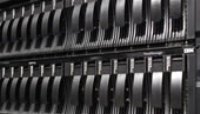Toshiba Launches Faster NAND For Solid State Drives

The company says its Toggle Mode NAND uses a faster interface than conventional asynchronous NAND memory, with lower power consumption than other synchronous DDR NAND chips
Storage solutions specialist Toshiba has announced 32nm double data rate Toggle Mode NAND flash memory for use in solid state drives, in multilevel cell versions with densities of 64GB, 128GB and 256GB and single-level cell versions with densities of 32GB, 64GB and 128GB.
The company said Toggle Mode NAND features a faster interface than conventional or “legacy” asynchronous NAND memory and boasts lower power consumption than other synchronous DDR NAND product offerings.
 Toshiba said DDR Toggle Mode 1.0 NAND has an interface rated at 133 megatransfers/second (MT/s), compared to 40MT/s for legacy SLC single data rate NAND, more than three times the current generation SLC chips. The company said this speed makes it suitable for high performance solid state storage applications including enterprise storage. Toggle Mode NAND supports common legacy NAND commands including basic, multiplane and cache operations.
Toshiba said DDR Toggle Mode 1.0 NAND has an interface rated at 133 megatransfers/second (MT/s), compared to 40MT/s for legacy SLC single data rate NAND, more than three times the current generation SLC chips. The company said this speed makes it suitable for high performance solid state storage applications including enterprise storage. Toggle Mode NAND supports common legacy NAND commands including basic, multiplane and cache operations.
Megatransfers per second refer to the number of data transfers (or data samples) captured per second, with each sample occurring at the clock edge. In a double data rate system, the data is transferred on both the rising and falling edge of the clock signal. For purposes of measuring data transfers in this context, one Megatransfer equals 1 million transfers per second. Toshiba noted actual data transfer speed may vary depending on the device, read and write conditions, and file size.
Lower Power Usage
Since it uses an asynchronous interface similar to that used in conventional NAND, the Toshiba DDR Toggle Mode NAND requires no clock signal, which means that it uses less power and has a simpler system design compared to synchronous NAND alternatives, the company said. In addition, the DDR interface in Toggle Mode NAND uses a Bidirectional DQS to generate input/output signals (I/Os) using the rising and falling edge of the write-erase signal. Toggle Mode NAND also has on-die termination to help achieve less crosstalk. “Scalability to future high-frequency operation is enabled as a result of the bi-directional data signal,” a company release noted.
Toshiba recently announced a commitment to a new standard for advanced high-performance NAND flash memory, a DDR NAND flash with a 400Mbps interface. “This next generation Toggle Mode DDR NAND 2.0 is targeted to provide a three-fold increase in interface speed over Toggle DDR 1.0 and a 10-fold increase over the 40Mbps single data rate NAND in widespread use today,” the release stated.